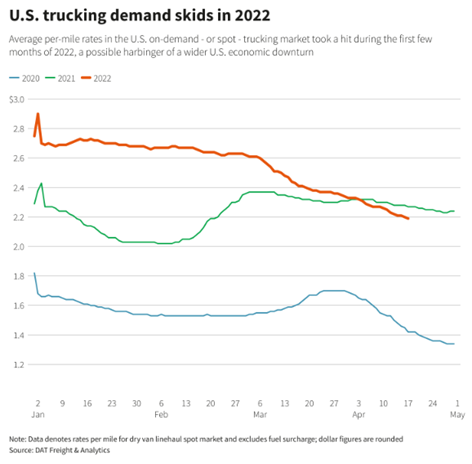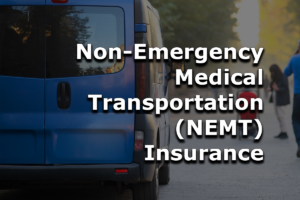According to a March 29, 2022 survey from Bloomberg, 48% of investors expect the US to fall into recession sometime in 2023, 21% expect the downturn to happen in 2024, and 15% expect the recession to come in 2022.
It is time to be honest with ourselves, the pandemic trucking industry is gone, and we will likely never see this type of demand again.
The height of the trucking industry peaked during the supply chain crush at the beginning of the COVID-19 pandemic.
At one point, the truckload spot market was handling more than 1 million loads per day, versus its historical average of about 400,000. In their rush to keep up, retailers and shippers focused on speed over efficiency by using more trucks.
While the rates during the pandemic helped trucking, this has caused a lot of people chasing the pandemic trucking industry, setting unrealistic expectation, and have caused new carriers to settle into expensive leasing deals.
For now, truckers should be able to cope, as the market is still affected by supply chain challenges and “driver shortages”.
But what if the downturn gets worse, leading into a recession? What can you do to lower your risk in a weaker industry?
What trucking statistics predict a trucking recession?
Let’s first take a quick look at the market.
On April 28, 2022, the U.S. GDP declined 1.4% when annualized in Q1 of 2022. Recession is technically when the GDP declines for two quarters in a row or longer.
Since March 2022, the trucking industry is seeing a big slowing that coincides with fuel prices rising 26% nationally, and now sit 62% higher than the same time last year.
Demand tumbled in March, when retail sales (excluding purchases of gasoline) fell 0.3% and online sales declined for the second month in a row.
And now, trucking’s most demand-sensitive sector – the spot market – is in correction territory.
While DAT Freight & Analytics reported a 2.2% increase in spot load postings overall for the month of March, truck posts increased much more, 29%, sending the van load-to-truck ratio plummeting 37.7%, reefer load-to-truck almost 39%.

According to Eric Starks, CEO and Chairman of FTR Transportation Intelligence in an Overdrive Magazine interview, “If the definition of a ‘freight recession’ is coming off of a peak and going back to a normal level, then we’re in for a [freight] recession. But I don’t think that’s what’s being discussed here. If we go into a real recession, where things start to fall off and freight truly declines, where things don’t normalize but actually weaken, that’s a real recession. Normalize just means we’re not going to see 20% to 30% increases in freight rates, just more in the normal three to five percent range” over the course of a year.
Who in the trucking industry is affected the most in a recession?
Naturally, the larger fleets have ways to protect themselves during an economic downturn. But there could be a trucking bloodbath on the way for owner-operators and new venture carriers.
Many owner-operators, unlike larger fleets, buy fuel at the pump price. With those prices soaring and sometimes a considerable lag of cashflow with 30+ days to receive payments after finishing a load, the recent rate drop and fuel hike creates a tricky situation.
We expect the owner-operator to bear the brunt during a freight recession, especially new-to-the-market owner-operators who purchased used trucks at record-high prices. They will have to auction their trucks or go back to truckload carriers.
Roadmap to Success: Free guide to startup and run a successful trucking company.
And here lies the problem.
Used truck prices soared due to a shortage of new equipment. Of the 130,000 new carriers since the pandemic, the majority are one or two truck operations driving used trucks.
What can owner-operators and small fleets do to prevent recession risk in their fleet?
Do not wait until a recession hits, you can start preparing now.
Read more: 8 STEPS TO PREVENT RECESSION RISK
Lower risk and increase safety. Generally, trucking companies with minimal loss activity, utilizing telematics data, and great CSA scores are in a better position to gain access to more insurers with better pricing. It is time to:
- pay some of your biggest debts when the money is good
- expand access to capital, lines of credit, and cash resources
- maintain a clean driving history
- pay all new bills on time
- build strong relationships with trusted brokers and shippers, and
- consider a mock DOT audit to make sure any FMCSA regulations are falling through the cracks
Control Cash-flow. One of the biggest challenges for carriers is cash-flow. There are costs paid out up-front before you even move a load, including: insurance, equipment investments, operating authority, fuel, maintenance costs, etc. Slow paying customers are also a problem, over 30 days to get paid.
To take control of your cash-flow:
- vet your customers (get credit checks and bank references, learn from their other vendors on how they pay their bills, keep notes on customer payment history, avoid slow-paying customers)
- state your terms clearly on both the credit application, rate advisory, and invoices before moving the load with them
- stay away from load boards, if possible, as strong customer relationships will usually offer the best rates
- make receivable calls the day an invoice is due, work your receivables weekly, and run account receivable reports weekly
Base decisions on data. The best source of information is your ELD telematic data. Since most interstate trucking companies were required to add electronic logging devices (ELDs) to their trucks, back-office management has been given an opportunity to better manage their vehicles and drivers when it comes to violations, driving habits, audits, maintenance, and more. Don’t forget to create and optimize a Preventative Maintenance schedule that includes service reminders so you pay less in unexpected maintenance problems instead of issues on the road.
Strengthen relationships with your customers. Building relationships with your customers, while generally being interested in how they conduct their business, will strengthen that relationship. A happy customer will expand your book of business through word-of-mouth referrals. The goal is to be a part of the shipper’s supply-chain and being an asset to their success. Also, having a loyal repair shop will also get you’re the best rates.
Enter the contract market. Even if spot rates continue to decline, owner-operators can take their trucks into contract work with big fleets. While there may be overcapacity within the spot market, that doesn’t mean there is overcapacity in the contract market. Many shippers are in the middle of negotiations, as motor carriers have given an initial offer, then calling in to say they would like to adjust it down even further to protect their revenue. That is happening right now.
Read more: 5 Steps to Find Issues in your Fleet Before the DOT
Work more. If you have been making more during the pandemic, you may have been doing so while driving less. Many made $71,000 during the pandemic comparted to $67,000 the year prior, and they did so while driving thousands of miles less. It may be time to take on more loads and drive more miles.
Work more efficiently. With fuel prices still above $5 a gallon, it is imperative that carriers find ways to reduce empty miles and keep the wheels moving underneath loaded trailers. Also, if you are an owner-operator handling every aspect of your business, it may be time to work with a third party that can handle safety regulations, driver and vehicle paperwork, taxes, drug testing consortium, and more. We at Compliance Navigation Specialists can be your partner so you can focus more on finding better loads and stay on the road.
Have an exit strategy. If you can, it may be time to park the truck and take a break if rates and fuel prices don’t add up to profitable loads on the spot market. Know what your exit strategy is and be willing to walk away when the line gets crossed.
Don’t get stuck in bad insurance coverage
The worst situation to be in is getting bad commercial truck insurance coverage and being committed to it for a year when one accident can ruin your business.
We recommend you start a custom quote online or call us directly to speak with a licensed trucking insurance professional.
Before we can get you an estimate, we are going to need some information.
Fill out a complete quote or quick quote to get started.
If you have any questions or concerns, please call us at 800.724.5523 or email info@cnsinsures.com.






